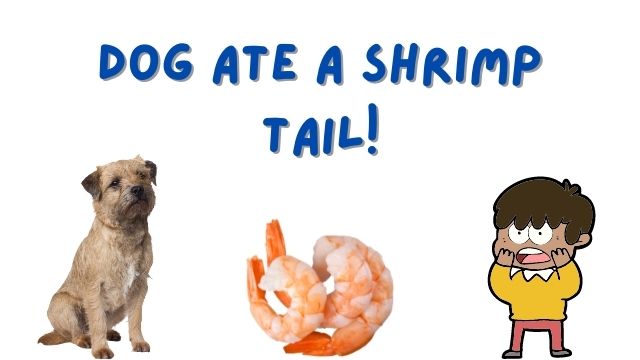Shrimp is quite a popular delicacy. In fact, it is one of the most consumed kinds of seafood in the United States. It’s therefore fair to say that there’s at least one American making some shrimp in their kitchen every night. And with our obsession with dogs, there’s at least one dog in the room where this is happening.
But what happens when your dog eats a shrimp tail? After all, this is quite on-brand for them – they are the same adorable fur balls that sometimes eat q tips and carpet padding. Well, we have some good news for you – it’s not the end of the world.
There are ways you can handle this situation. And we’re here to talk about them. We will also talk about what happens to your dog when they eat a shrimp tail and whether you should be worried. No matter how bad the situation looks, we’re here to give you the information you need to make it through.

What Happens if A Dog Eats Shrimp Tails?
First of all, shrimp tails can easily choke your dog or block its intestines. Secondly, your dog can have an allergic reaction to shrimp. Beyond that, raw shrimp tails may still have viruses and bacteria that can make your dog sick. It also doesn’t help that shrimp tails are high in cholesterol and can aggravate your dog’s hypertension.
Since shrimp tails are made of chitin, dogs can’t digest them – that’s why they are a choking hazard. If you have a puppy or small breed of dog, it is particularly easy for this to happen, especially when they are eating big tails. As such, shrimp tails should never be included as part of your dog’s diet. So if your dog gets excited whenever they see shrimp tails, distract them with a digestive support chew instead.
This will keep their digestive systems healthy without any risk of choking. Unlike raw shrimp tails, these chews also don’t contain Salmonella and Vibrio – pathogens that are harmful to dogs, other pets, and even humans. Ultimately, the risks involved with feeding your dog shrimp tails far outweigh any nutritional advantages. Turning to alternatives like boneless cooked salmon or sardines is a safer way to get your dog the phosphorus, antioxidants, and vitamins they need.
Should I Be Worried if My Dog Ate a Shrimp Tail?
Yes, you should be worried if your dog eats a shrimp tail. Even if they do look okay and aren’t choking or having an allergic reaction, the shrimp tail could be causing an intestinal blockage. Alternatively, they could cause internal damage and bleeding.
Another thing to keep in mind is that if your dog has never had shrimp before, you may not know how their shrimp allergy exhibits itself. This means that by the time you notice that the shrimp is affecting them, too much time might have passed. And in the case that your dog ate shrimp tails that weren’t completely cooked, it may take some time before you notice any resulting bacterial or viral infection.
Ultimately, complications due to ingestion of shrimp tails could be life-threatening for your dog. Fortunately, if you know what to do when your dog eats shrimp tails, it is unlikely that things to get this bad. To prevent this from happening in the first place, though, avoid letting your dog eat alone and preparing/cooking/eating shrimp tails around them. Also, provide your dog with enough food and train them not to scavenge through garbage or debris.
What Can I Do if My Dog Ate a Shrimp Tail?
You should call a vet immediately if your dog eats a shrimp tail. While chances are they’re fine, this could be a medical emergency. The situation is particularly serious if you notice signs of an infection, allergic reaction, or intestinal blockage. These include itchy skin, nausea, abdominal pain, diarrhea, vomiting, itchiness, and in worse case scenarios, anaphylactic shock.
Once you go in to see the vet, they may ask you about your dog’s medical history, perform a physical exam on them, take some X-rays, and/or take some lab tests. After they have a clear diagnosis, they may recommend surgery or prescribe drugs that offer your dog digestive support and alleviate pain/discomfort. If the vet decides to take your dog into emergency surgery, it means that the shrimp has caused a blockage that can’t be fixed using less invasive treatment options. Usually, such surgeries are serious procedures that can take hours and will require your dog to be put under anesthesia.
After the surgery, your dog will have to remain in the hospital for several days, with the first three being the most critical. During this time, your dog is at risk of getting blood poisoning (sepsis), having a low protein count (hypoalbuminemia), and having their wound open up (dehiscence). It’s therefore important for you to monitor them and ensure they get enough rest, food, and fluids throughout their recovery. Also, you’ll have to ensure they take their post-surgery medication properly – this will relieve any pain and help them fight off infections.
Conclusion
While many dog owners swear that their dogs have eaten shrimp tails before without experiencing any negative consequences, it is too big of a risk to take. Supposing things go wrong, your dog will not only be in pain but may also have to get surgery that costs anywhere between $800 to $7000. So if you must feed your dog shrimp, ensure they don’t have an allergy, aren’t struggling with high cholesterol, and that the shrimp are completely cooked and free of tails/shells. If you feel like this is too much of a hassle, both you and your dog are better off with another food option.

